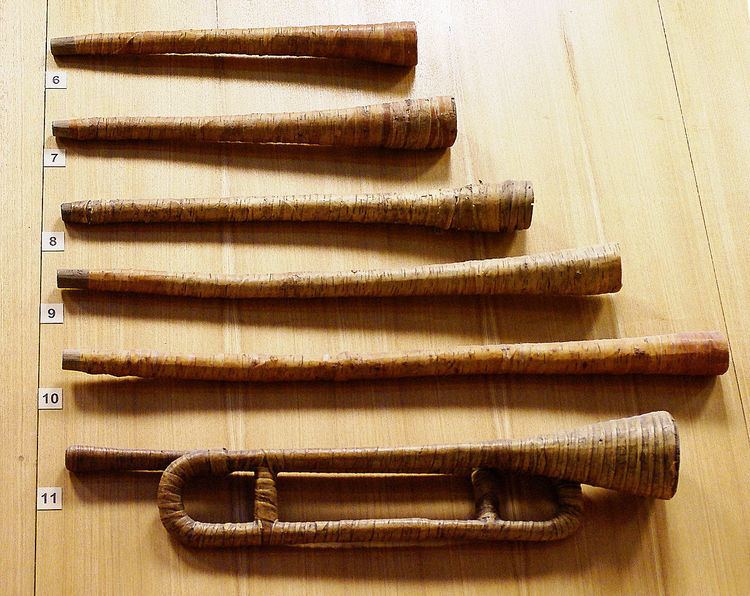 | ||
The vladimirskiy rozhok (Russian: Владимирский Рожок), also called Vladimir horn, is an ancient Russian wooden trumpet, a relative of the cornett, which has remained in continuous use until the present day.
A rozhok is a conical straight tube with the six playing holes: five on top and one underneath. The total length of a rozhok ranges from 320 to 830 mm (13" to 33"). A mouthpiece is cut in the form of a small cup, and the lower end of the tube is shaped like a conical bell. A rozhok is usually made of birch, maple, or juniper. Musicians say that rozhoks of juniper have the best sound. In the past they were made in the same manner as a shepherd's rozhok, in which two halves are fastened together with birch bark; today they are turned. The sound of a rozhok is strong, but mellow, having a range of about an octave, or a little more. There are several types of rozhoks: the shortest one, having the highest sound is called vizgunok (squeaker), typically in F# or G; the longest and thus the lowest one is called bas (bass), in F# or G an octave below, while a mid-size instrument is called a polubasok (half-bass), typically in C. It is polubasok instruments that are most frequently used for solo playing. Rozhok ensembles usually consist of just vizgunok and bas instruments in the ratio 2:1 (twice as many high-pitched horns).
The origins of the instrument date to before AD 1600. The tradition of playing the rozhok in an ensemble probably dates to a much earlier time. It is possible that the name rozhok was used for the instrument later, and that in the earliest written sources it was simply called a pipe. A rozhok can be called be various names: shepherd’s, Russian, or song rozhok. At the end of the 19th century, the name Vladimir was added to this instrument's name, due to the success of a chorus of rozhok players under the leadership of Nikolai Vasilyevich Kondratyev from the Vladimir region.
Rozhok’s folk tunes are divided into four stylistic varieties: signal, song, dancing, and dance, with a large number of songs in all styles. There are several types of shepherd's signals and more of others. The main repertoire is song folk-tunes.
As of 2015, rozhok ensembles exist in Moscow, Vladimir and Nerekhta. In addition, rozhoks can sometimes be heard in Russian folk orchestra concerts.
